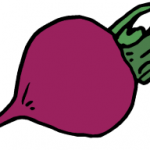 Sugar beet processing is a relatively simple process. The beets are washed and sliced up. Sucrose is extracted from the slices with hot water, and the solution obtained is purified by precipitating calcium carbonate in it. Impurities are trapped in the precipitate and filtered out. The process is repeated several times to give a clear solution. Vacuum evaporation is used to concentrate the solution – which is seeded and cooled so that the sugar crystallizes out.
Sugar beet processing is a relatively simple process. The beets are washed and sliced up. Sucrose is extracted from the slices with hot water, and the solution obtained is purified by precipitating calcium carbonate in it. Impurities are trapped in the precipitate and filtered out. The process is repeated several times to give a clear solution. Vacuum evaporation is used to concentrate the solution – which is seeded and cooled so that the sugar crystallizes out.
Much of the world’s sugar cane is harvested by handcutting after burning the crop to remove the leaves. However, mechanical systems such as push-rake cutting and grab harvesting have come into use. The cane arriving at the raw sugar factory is washed on conveyers to remove field mud, sand and trash. The cane is nearly 90 per cent juice and it was traditionally extracted by a combination of shredders and three-roll crushers which squeezed out the juice.
This process gave 95 per cent extraction of the juice, but this has been improved to greater than 97 per cent by the introduction of diffusion processes. One system, known as the ring diffuser, prepares the cane by shredding it in hammer mills, operating at 1000 rpm, which pound the cane with steel hammers. The shredded cane is fed to an annular, rotating perforated plate of the diffuser where sugars are extracted by recycled juice percolating through the cane at 160 to 165° F (71 to 75° C). The extracted cane, or bagasses, is removed from the diffuser by screw conveyers and can be used as a fuel in the steam-raising plant of the factory, which produces the steam used to heat the sugar and, in some factories, to drive the machinery.
Many of the impurities of raw cane juice are removed by adding a lime suspension to give a pH of 8.5 and heating to about 220° F (104° C), which is maintained for 20 minutes. Acids are neutralized and the phosphates present are flocculated (coalesced) and adsorb coloring matter and colloids (suspended particles), which are subsequently removed by settling for about three hours in clarifying tanks. Next, the clarified juice is concentrated to about 65 per cent by weight of sugar in a multieffect (multistage) evaporator system.
The juice temperature in the first evaporators is about 229° F (109.5° C) and the pressure in succeeding evaporators is reduced so that the juice boils at 153.3° F (67.5° C) in the fourth effect. Vapor generated in each evaporator is condensed in the heating tubes of the next effect, thus economizing on the use of steam.